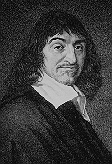
René Descartes
1596-1650
If four plane right angles are multiplied by the number of solid angles & from the product are subtracted 8 plane right angles, there remains the sum of all the plane angles which exist on the surface of that polyhedron.

Descartes' Lost Theorem

René Descartes 1596-1650 |
Somewhere in the years 1619-1621 René Descartes wrote an
Elementary Treatise on Polyhedra in which, very near the beginning,
the following statement appears:
If four plane right angles are multiplied by the number of solid angles & from the product are subtracted 8 plane right angles, there remains the sum of all the plane angles which exist on the surface of that polyhedron. |
For example, a right prism on a regular hexagonal base has twelve solid angles. Continuing with Descartes' terminology, but converting to degrees for the calculation (one plane right angle = 90 degrees):
_____
/ \
/ /|
|\ _____ / |
| | | |
| | | /
\|_____|/
Hexagonal prism has
twelve solid angles.
|
|
This remarkable theorem is not part of the history of mathematics. It was never published, and lay hidden for over 200 years.
In this column we will examine Descartes Treatise as a mathematical time capsule, giving us a look back at the beginning of the XVII century, and showing us how its author's geometrical intuition allowed him to anticipate some of the more interesting mathematical discoveries of the next two centuries.
--Tony Phillips